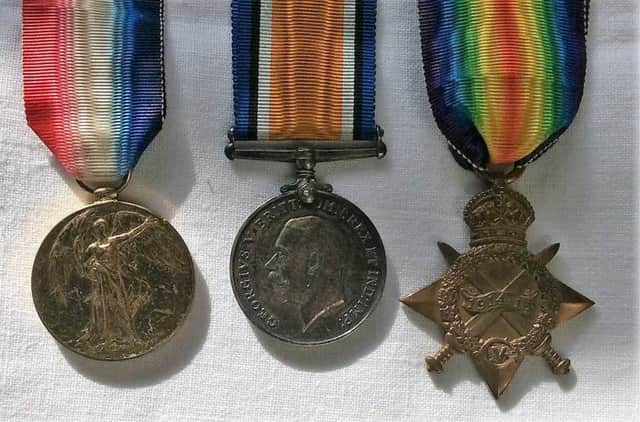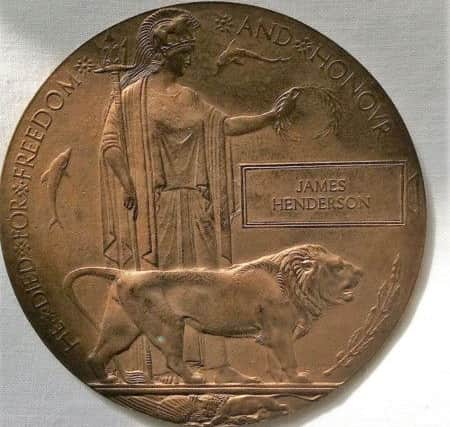The year when a brutal war reached a new level of horror - and a South Hetton man paid with his life


When the horror of the First World War reached a new level and a weapon of destruction entered the theatre to devastating effect – the tank.
It was a year when machine gun regiments became the norm and deaths ran into their thousands. And when Wearside man, Private James Henderson, perished after only three years as a soldier.


Advertisement
Hide AdAdvertisement
Hide AdHe is the latest South Hetton serviceman to get the attention of researcher Kevin Dance.
Kevin, originally from South Hetton, has painstakingly researched the men of his birthplace who went to war and paid with their lives.
James was a coal miner hewer from Gale Street - one of two brothers living with his parents Thomas, 60, and Jane, 59.
But in November 1914, he volunteered to serve his country. By October 1915, he was in France with the 7th Battalion East Surrey Regiment at the thick of the action to the north of Loos.


Advertisement
Hide AdAdvertisement
Hide AdHis battalion, said Keven, “suffered very heavy casualties in and around the Hulluch and Hohenzollern Redoubt battle areas”.
It led to a new development for James and many others like him.
“In February 1916, the 37th Machine Gun Company was formed as part of the 12th Division (British 3rd Army) from machine gun sections of the 6th Queens Royal West Surrey, 6th Buffs East Kent, 7th East Surrey, and the 6th Queens Own Royal West Kent regiments,” said Kevin.
Soon, he was in a team of men responsible for a Vickers machine gun. The 37th Machine Gun Company was made up of ten teams.


Advertisement
Hide AdAdvertisement
Hide AdKevin added: “The Vickers Machine Gun was a tripod mounted weapon (water cooled due to the heat it produced when firing) and it fired .303 inch bullets,” said Kevin.
“It could fire something like 10,000 rounds per hour and would do this all day long accurately and without any glitches over distances up to 4,000 yards. “It was a deadly weapon and a strategic piece of equipment for any division.”
Almost as soon as it was formed, the new company was in battle action at the Hohenzollern Redoubt in early March 1916.
Then, it racked up a series of battle actions including The Somme, The Battles of Albert, Pozieres Ridge and Transloy Ridge – all before 1916 was out.


Advertisement
Hide AdAdvertisement
Hide AdAs 1917 dawned, little changed and the list of actions for Private Henderson and his colleagues kept on growing.
The 37th MGC had moved to Arras and were involved in the 1st Battle of the Scarpe, Battle of Arieux, and the 3rd Battle of the Scarpe.
“They were then involved in the attack on Devils Trench and, as part of the 12th Division successfully held their line just east of Monchy for 18 weeks.”
But the decisive action for James Henderson was still to come.
Advertisement
Hide AdAdvertisement
Hide AdIn late November 1917, the machine gun company was moved to Cambrai and involved in a massive attack on the Hindenburg Line.
As well as machine guns, tanks formed part of the attack – and not just one or two of them. The Allies stormed forward with 476 tanks in their lines.
“Following this successful attack the 12th division made further gains notably at Bourlon Wood,” said Kevin.
“Unfortunately between November 30 and December 3, 1917, the Germans counter attacked with great force and most of the ground gained by the British initiative was lost.”
Advertisement
Hide AdAdvertisement
Hide AdLand was not all that the British Army lost. The dead, wounded and missing amounted to 44,000 in just 18 days. Six thousand men were taken prisoner during the German counter attack on one day alone – November 30.
And the Germans paid their own heavy price with 45,000 casualties.
It was during that counter attack on November 30, 1917, that James Henderson was killed.
“He is remembered with honour at the Cambrai Memorial, Louverval, France which is about 10 miles west of Cambrai, said Kevin.
Advertisement
Hide AdAdvertisement
Hide Ad“James Henderson was awarded the Victory, British, and 15 Star Medals. His widow Sarah was awarded 25 pounds, 11 shillings and 7 pence.”
He was a South Hetton born and raised man who didn’t sign up for war until he was 35. We thank his descendants and Kevin for sharing a story of yet another man who paid with his life for his loyalty to his country.